
Original Link: https://www.anandtech.com/show/2742
The SSD Update: Vertex Gets Faster, New Indilinx Drives and Intel/MacBook Problems Resolved
by Anand Lal Shimpi on March 30, 2009 12:00 AM EST- Posted in
- Storage
When we last left off Intel’s X25-M continued to prove its worth as the best desktop SSD on the market today. But there was new hope in a small controller company based in Korea called Indilinx. Thanks to some quick acting, Indilinx and OCZ were able to put forth the first true value alternative to the X25-M: the Vertex SSD.
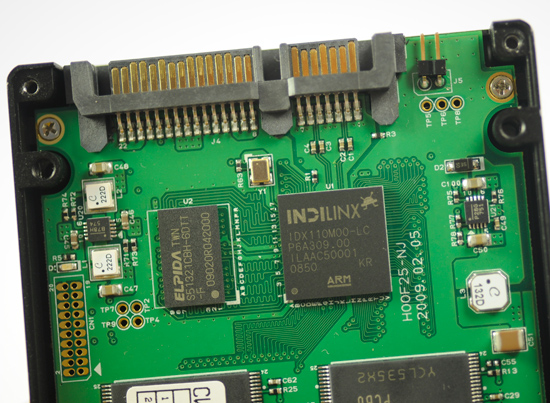
In Indilinx we Hope
Now other manufacturers are beginning to ship Indilinx Barefoot based SSDs and the latest updates to the controller’s firmware make the SSD even faster than what I tested just a week ago.
Although I thought I’d be done with SSDs last week, the saga continues with a few minor updates important to anyone looking to buy an SSD today.
The Intel Update
I met with Intel this week to talk about its SSD roadmap as well as where the X25-M is today. Unfortunately I can’t talk about most of the details yet, but more information is coming.
The performance issue PC Perspective uncovered is indeed a real issue, although not something that I’ve been able to run into outside of running specific benchmark patterns. I mentioned it was a non-issue in my last article and now, armed with even more information, I’m even more confident in that. I can’t say much now, but it won’t be too much longer before I can.
A few readers wrote me and asked why the X25-M doesn’t work under Bootcamp on NVIDIA based Apple systems (e.g. the new MacBook/MacBook Pro). I didn’t have an answer at the time but I looked into it. It turns out that there is a compatibility issue with some of the 80GB X25-Ms and those platforms, but Intel does have a fix.
For starters, if you have a 160GB X25-M or X18-M, you aren’t affected by this issue; bootcamp will just work. The latest production of the 80GB X25-Ms are also not affected by this issue, but not the original drives. If you have an earlier X25-M and one of these Apple machines and are experiencing Bootcamp compatibility problems Intel wants you to contact its support staff for a fix: http://www.intel.com/support/
Remember what I wrote in my last SSD piece: “I’d venture a guess that Intel would not leave its most loyal customers out in the cold after spending $400 - $800 on a SSD. I can’t speak for Intel but like I said, stay tuned.”
I’ll have more updates on the Intel drive in the coming weeks.
The Vertex Update
As you’d expect, a lot has happened since the article went live. On my end, I’ve started compatibility testing on the OCZ Vertex drives. As I mentioned at the end of last week’s article - OCZ and Indilinx, even collectively, aren’t anywhere near as large as Intel.
Firmware changes to the X25-M go through weeks upon weeks of validation at Intel; if the validation process is anything like it is for all other Intel components, the process is carried out on hundreds of servers making sure that every possible scenario is tested on the drive. Intel studied the usage pattern of hard drive users for quite a while before the X25-M ever made it to a reviewer’s hands; that’s why we didn’t have the stuttering problems on those drives. That’s why they just worked as intended right out of the box.
That’s also why the Intel drive commands such a high premium.
| Cost Per GB from Newegg.com | |
| Intel X25-M 80GB | $4.29 |
| OCZ Vertex 120GB | $2.91 |
| Western Digital Caviar SE16 640GB | $0.12 |
| Western Digital VelociRaptor 300GB | $0.77 |
OCZ and Indilinx want to slot their drive in between the JMicron garbage and the Intel drive. Unfortunately, without the resources of an Intel - it’s difficult to deliver the same sort of experience. That’s not to say that the only solid state options come from Intel, it just means that you should probably check to see if there are any compatibility issues before you pull the trigger on the Vertex.
Reading through OCZ’s forums there have been reports of drives not working in some notebooks. While the Vertex worked just fine in my X58 testbed, that’s hardly the most common motherboard out there. So before I left for GDC last week I started compatibility testing on the Vertex. I met with OCZ at their offices to share notes on compatibility testing with these drives. For example, I’ve seen issues with the ASUS P5B Deluxe and the P5K Deluxe and the Vertex drive being detected properly (or taking a long time to detect) but OCZ has not. I want to find out why.
I’ve also heard limited reports of Vertex drives dying after heavy use. The data loss/corruption issues appear to be related to firmware 1199, a revision newer than the 0112 version I tested with for last week’s article. While I recommended that OCZ ship with the firmware I tested for my review, it looks like some drives shipped with 1199. I don’t have exact numbers of how many drives used 1199 vs. 0112, but there are some out there in the market. Sigh.
The problem was quickly identified by customers, OCZ and Indilinx and fixed in a very short period of time with the 1275 revision. If you have a drive with the 1199 firmware it’ll appear as such in the BIOS and your best bet is to contact OCZ directly for the new firmware and instructions on how to upgrade to it.
While it’s great that OCZ has been proactive in releasing firmware updates, every time you update your firmware you do lose all of the data on your drive. If you keep persistent backups then it’s not a big deal; if you don’t, it’s a pain.
The Bright Side: The Vertex is Nearly 3x as Fast
Immediately after I published the anthology, I asked OCZ for a shipping version of the drive. I wanted final hardware, updated firmware, shrink wrap, the whole 9 yards. Here’s what I got:
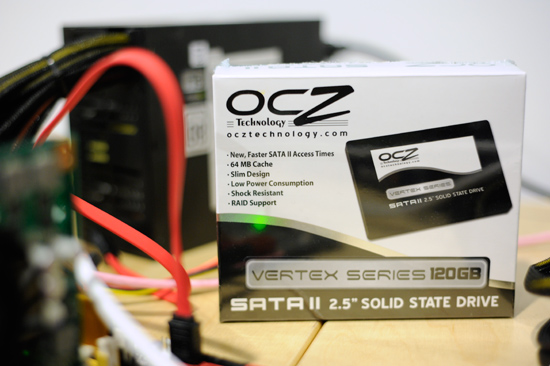
The drive itself looked identical to the first Vertex I tested, but the differences were all internal. The new drive used a new PCB layout, let’s pop the top off to see it:

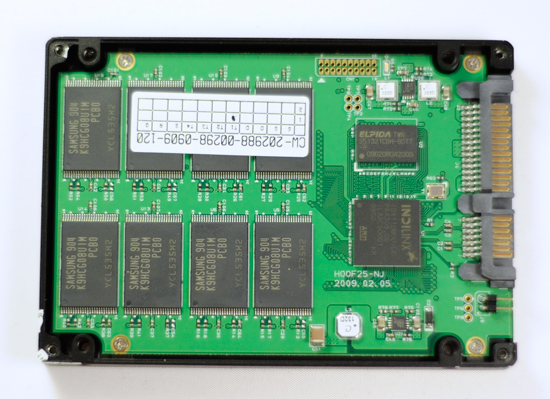
Oooh.
The major change on the new board layout is the addition of a 2-pin jumper on the back of the drive to allow the drive’s firmware to be updated by the end user. OCZ tells me that as of 1275, the jumper is no longer needed to update the firmware so it looks like it was a short lived change.
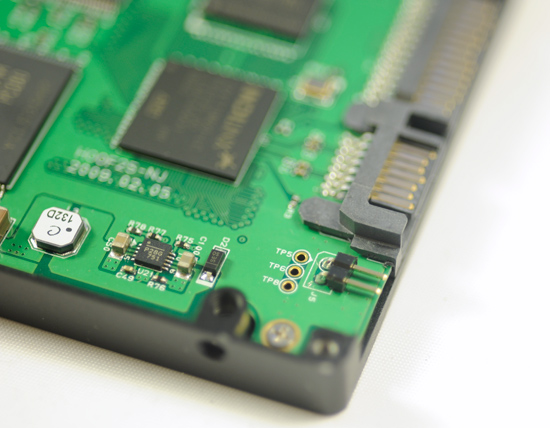
While OCZ claims that there’s significant validation done on each firmware revision, without a doubt it’s significantly less than what every Intel and Samsung drive goes through. There’s a certain amount of risk you take when jumping on the unproven hardware bandwagon, so as always proceed with caution. It’s worth looking into
While I haven’t done much testing on 1275, I can’t blame you if you want to try the firmware out right away because it is good.
I’ll start with the best news first. I looked at 4KB random write performance once again using iometer. This test is the same one I used in last week’s review; a 3 minute run, 3 outstanding IOs, 4KB random writes spread out over an 8GB section of LBAs. I filled the drive completely before running the test.
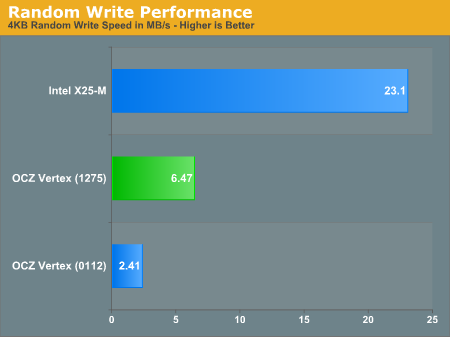
| Random Write (4KB Block, 3 IOs) | IOPS | Transfer Rate | Average Latency (ms) |
| Intel X25-M | 5923 | 23.1 MB/s | 0.51 ms |
| OCZ Vertex 1275 | 1656 | 6.47 MB/s | 1.81 ms |
| OCZ Vertex 0112 | 617 | 2.41 MB/s | 4.86 ms |
Yeah. It’s fast. Not quite as fast as Intel’s X25-M but it’s good. Average latency has dropped quite a bit. The Vertex using firmware 1275 performs used at about the level that the original firmware performed brand new. The Intel drive can still crunch through over 3.5x the number of IOs per second as the Vertex, but it also costs nearly 2x per GB. The Vertex proves itself an interesting value alternative.
I then looked at random read performance. Now most SSDs do just fine here, even the JMicron based ones.
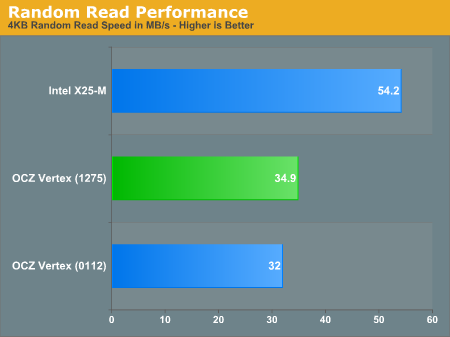
| Random Read (4KB Block, 3 IOs) | IOPS | Transfer Rate | Average Latency (ms) |
| Intel X25-M | 13883 | 54.2 MB/s | 0.22 ms |
| OCZ Vertex 1275 | 8931 | 34.9 MB/s | 0.34 ms |
| OCZ Vertex 0112 | 8184 | 32.0 MB/s | 0.37 ms |
The new firmware bumped up the Vertex’s performance by about 9%.
I spoke briefly with one of OCZ’s flash engineers and it seems like the reason the 1275 firmware is so much faster in random write speed is because of a bug in the 0112 firmware I tested with. There was apparently a problem with the 0112 firmware that prevented the controller from writing to as many flash devices as possible in parallel. The 1199 firmware fixed this, which explains why the sudden rush to ship the firmware. Unfortunately it looks like that version also has problems and thus we end up back at square one again. There’s no free lunch folks.
Sequential read performance showed a very marginal performance improvement:
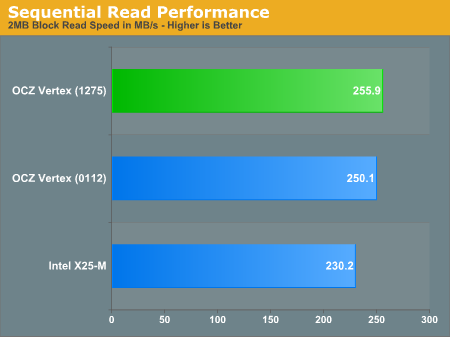
| Sequential Read (2MB Block, 1 IO) | IOPS | Transfer Rate | Average Latency (ms) |
| Intel X25-M | 115.1 | 230.2 MB/s | 8.7 ms |
| OCZ Vertex 1275 | 127.9 | 255.9 MB/s | 7.8 ms |
| OCZ Vertex 0112 | 125.1 | 250.1 MB/s | 8.0 ms |
But sequential write performance went up tremendously:
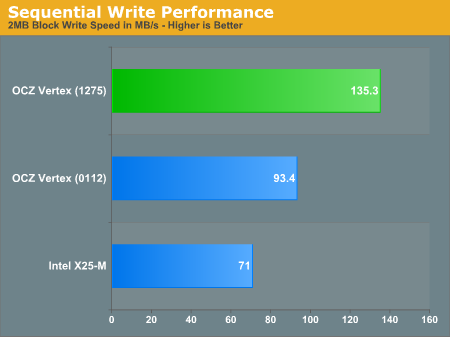
| Sequential Write (2MB Block, 1 IO) | IOPS | Transfer Rate | Average Latency (ms) |
| Intel X25-M | 35.5 | 71 MB/s | 28.2 ms |
| OCZ Vertex 1275 | 67.7 | 135.3 MB/s | 14.8 ms |
| OCZ Vertex 0112 | 46.7 | 93.4 MB/s | 21.4 ms |
The Indilinx (and most other) drives offer better sequential read/write speed than the X25-M. Intel optimized for the most important characteristics for a desktop: random read/write performance, while most other manufacturers optimized for sequential read/write. Indilinx is the first to seem to want to really drive sequential without completely forgetting about random performance.
Real World Sanity Check
I wouldn’t dream of just relying on iometer tests to make sure that the new firmware actually made things faster - it’s far too easy to optimize for just a couple of tests. I spot checked the Vertex’s performance with the 1275 firmware using a few application launch benchmarks:
The Fresh Test is the 3-application launch benchmark I used in the original review. For those who don’t remember, I fired the testbed up and immediately upon hitting the Windows desktop I launched three applications (Photoshop CS4, Pinnacle Studio 12 and IE7). Pinnacle also had a large project to load on top of all of that. I reported the time it took to load all three applications.
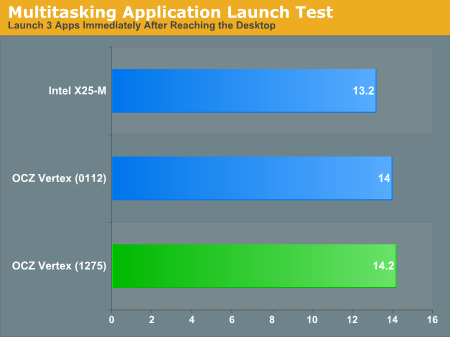
As you can see, performance is about the same between 0112 and 1275. So far, so good.
I ran a couple of application launch tests and the 1275 firmware performed similarly to the original:
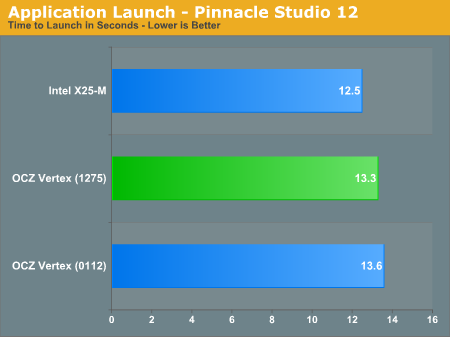
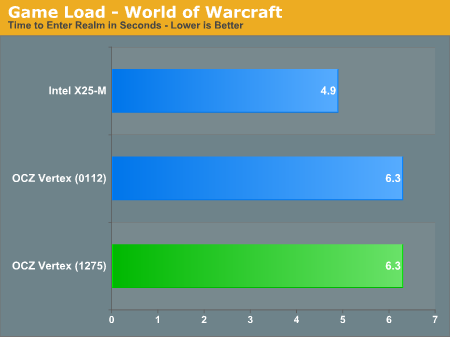
I used PCMark Vantage as another spot-check for performance. While application launch tests are mostly random read benchmarks, Vantage stresses both reads and writes - the latter showing a large improvement on the new firmware:

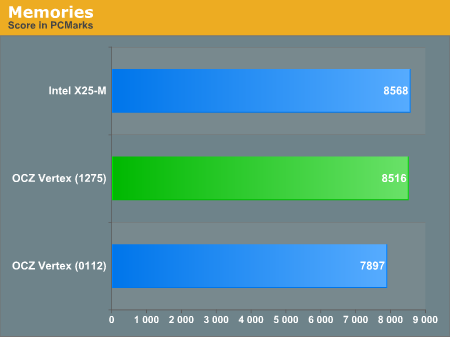
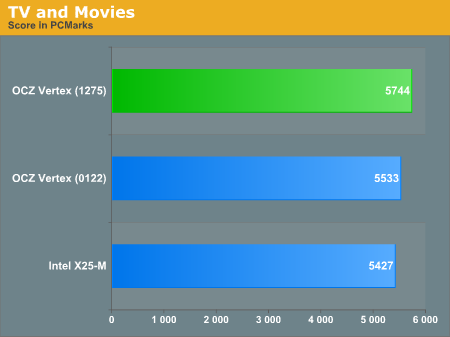
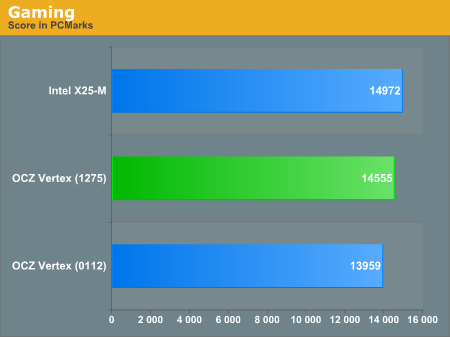
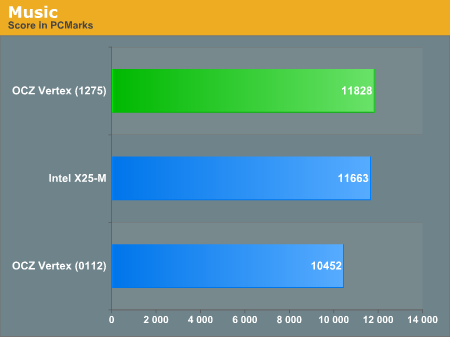

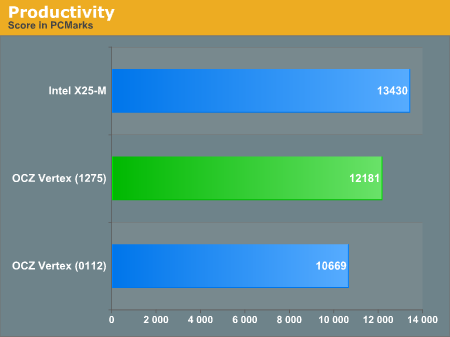
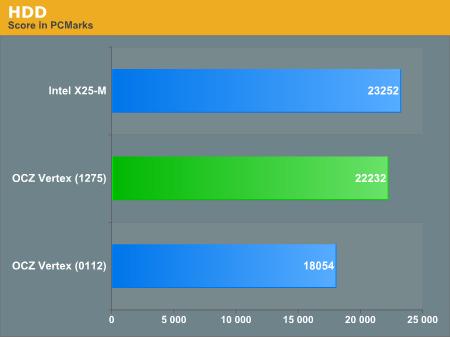
Vantage showed a close to 10% improvement in overall performance, and 23% when we’re just looking at the synthetic HDD benchmarks. Surely the performance increases are all due to the Vertex’s improved write speeds; in some scenarios the gains are large enough to be noticeable in normal use of your machine.
FC-Test: Just to Make Sure
I ran one more set of tests to further vet the updated firmware. Using Xbitlab’s FC-Test I ran a few file creation and file copy benchmarks on the Vertex. The benchmark will simply create a directory full of files and then, at your request, time how long it takes to copy those files. The number and size of the files depend on the pattern you ask FC-Test to use. You can also create your own patterns based on existing files and directories on your system. To keep things simple I ran three tests: 1) Copying ISOs, 2) Copying MP3s and 3) Creating the FarCry 2 installation directory. The first two come with the benchmark, the last one I made using my FarCry 2 installation directory - it’s the closest I could come to simulate a game-installation benchmark.
The performance improvements speak for themselves:
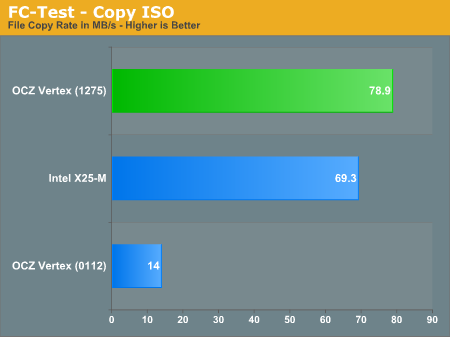
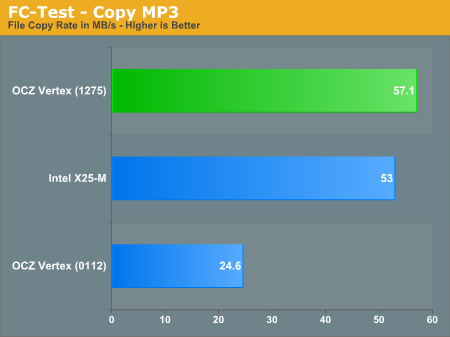
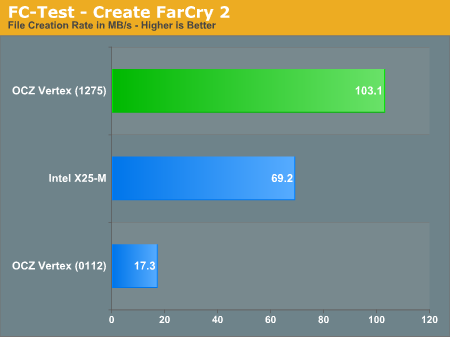
All in all the 1275 firmware looks to be promising. While it won’t make the Vertex into something it’s not, it will make the drive an even bigger value if we can be sure that there are no added problems associated with the new firmware.
SuperTalent’s Indilinx Drive: The UltraDrive ME
Just before I left for GDC I got another SSD: SuperTalent’s UltraDrive ME. This is SuperTalent’s Vertex-equivalent, it actually uses the same Indilinx Barefoot controller. As far as I can tell, the drive uses the same firmware as OCZ’s 1275.
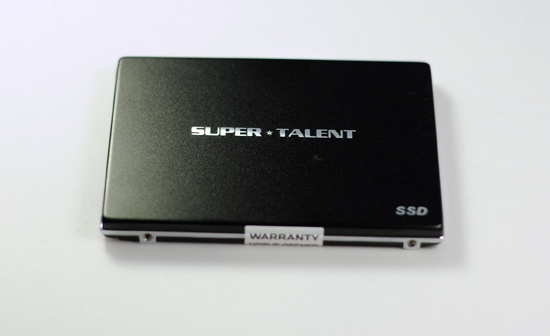
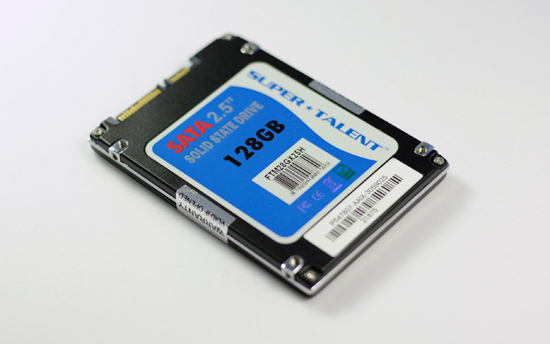
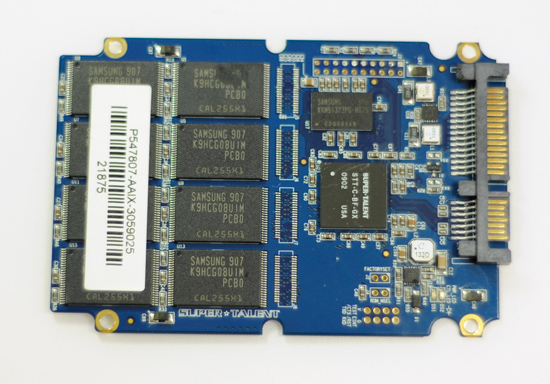
While I barely had any time with OCZ’s 1275 firmware, I had even less time with the UltraDrive ME. I ran my iometer random write test to see if this thing performed like the updated Vertex; it did:
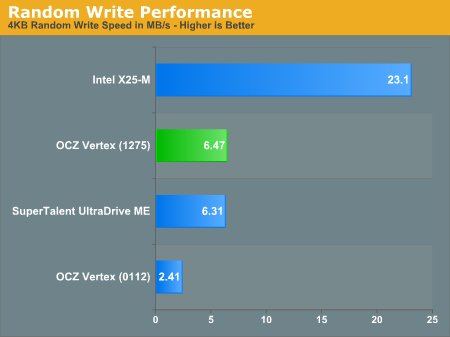
I spoke to three more manufacturers evaluating the Indilinx Barefoot controller during my time out in the bay area. The only complaints I’ve heard are that Indilinx is a very small company and the Barefoot controller is perhaps priced a little too high. With pressure from additional manufacturers, and as volumes go up, we should see these drives get even more affordable.
Final Words
My recommendation still stands: the Intel X25-M is by far the cream of the crop of the desktop SSD world. The Indilinx based drives have the potential to be good, lower cost alternatives to the Intel drive but you still have to approach them with caution. While the OCZ Vertex drive worked fine in my tests and on my testbed, this is a brand new drive with a controller from a company without a proven track record.
In the coming weeks I will be looking at the latest updates to Samsung’s MLC controller. While I haven’t been terribly impressed with the performance of Samsung drives thus far, they are at least reliable and compatible.
While I’ve heard that the JMicron based drives are no longer selling very well, it looks like at least a few manufacturers are going to be using the JMF602B controllers to deliver 512GB SSDs in the coming months. Buyer beware.
I will say this: outside of Intel, Indilinx appears to know what is important when it comes to SSD performance. With more companies releasing drives based on the Barefoot controller, we should hopefully see any compatibility problems get sorted out faster.
There is some even better news that has surfaced since last week. If the 1275 revision ends up being problem-free, it does deliver more than 3x the random-write performance of the Vertex I first previewed and a more than noticeable 10% boost in application performance. That’s not enough to dethrone Intel, but it is more than enough to make the Vertex even more desirable.
The gotcha still applies: this is the first version of an Indilinx controller we’ve seen in the desktop market. Compatibility and longevity have yet to be proven; so far my experience has been positive but that’s merely one datapoint. We have a long way to go my friends.
I’ll keep you posted.
...and Thanks
I spent a few hours last weekend responding to every single email I received about The SSD Anthology. I've got some recent ones that came in while I was at GDC that I still need to get to. For the first year or so of AnandTech I responded to every single email; it didn’t take too long for me to start getting a few hundred a day and for me to have to curb that a bit in order to actually get work done.
The outpouring of support and appreciation in response to my latest article was too good for me not to respond to every single person. To those of you who wrote me, commented, or just took the time to read the article - thank you.
Your words and support are what inspire me to, even today almost 12 years since I started AnandTech, continue to work on things like The SSD Anthology or The RV770 Story. Thank you.







